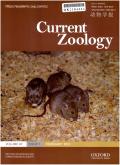Urbanization does not affect red foxes’ interest in anthropogenic food, but increases their initial cautiousness
IF 2
2区 生物学
Q2 ZOOLOGY
引用次数: 0
Abstract
Human presence and activities have profoundly altered animals' habitats, exposing them to greater risks but also providing new opportunities and resources. The animals’ capacity to effectively navigate and strike a balance between risks and benefits is crucial for their survival in the Anthropocene era. Red foxes (Vulpes vulpes), adept urban dwellers, exhibit behavioral plasticity in human-altered environments. We investigated variations in detection frequency on trail cameras and the behavioral responses (explorative, bold and fearful) of wild red foxes living along an urbanization gradient when exposed to a metal bin initially presented clean and then filled with anthropogenic food. All fox populations displayed an increased interest and similar explorative behavioral responses towards the anthropogenic food source, irrespective of the urbanization gradient. Despite no impact on explorative behaviors, foxes in more urbanized areas initially showed heightened fear towards the empty bin, indicating increased apprehension toward novel objects. However, this fear diminished over time, and in the presence of food, urban foxes displayed slightly reduced fear compared to their less urban counterparts. Our results highlight foxes' potential for adaptability to human landscapes, additionally underscoring the nuanced interplay of fear and explorative behavioral response of populations living along the urbanization gradient.城市化不会影响红狐对人类食物的兴趣,但会提高它们最初的谨慎程度
人类的存在和活动深刻地改变了动物的栖息地,使它们面临更大的风险,但同时也提供了新的机遇和资源。在人类世时代,动物有效驾驭和平衡风险与利益的能力对其生存至关重要。红狐(Vulpes vulpes)是城市居民的能手,在人类改变的环境中表现出行为可塑性。我们研究了生活在城市化梯度上的野生红狐在接触到金属桶时的行为反应(探索、大胆和恐惧)。无论城市化梯度如何,所有狐群都对人为食物源表现出更大的兴趣和类似的探索行为反应。尽管城市化程度较高的地区的狐狸的探索行为没有受到影响,但它们最初对空的垃圾桶表现出更大的恐惧,这表明它们对新事物的恐惧感增加了。然而,随着时间的推移,这种恐惧感逐渐减弱,在有食物的情况下,城市狐狸的恐惧感比城市化程度较低的狐狸略有减少。我们的研究结果凸显了狐狸对人类景观的潜在适应能力,同时也强调了城市化梯度上的狐狸种群在恐惧和探索行为反应之间微妙的相互作用。
本文章由计算机程序翻译,如有差异,请以英文原文为准。
求助全文
约1分钟内获得全文
求助全文
来源期刊

Current Zoology
Agricultural and Biological Sciences-Animal Science and Zoology
CiteScore
3.20
自引率
9.10%
发文量
111
审稿时长
6 weeks
期刊介绍:
About the Journal
Current Zoology (formerly Acta Zoologica Sinica, founded in 1935) is an open access, bimonthly, peer-reviewed international journal of zoology. It publishes review articles and research papers in the fields of ecology, evolution and behaviour.
Current Zoology is sponsored by Institute of Zoology, Chinese Academy of Sciences, along with the China Zoological Society.
 求助内容:
求助内容: 应助结果提醒方式:
应助结果提醒方式:


